She-Hulk: Attorney at Law stars Tatiana Maslany (Orphan Black) as Jennifer Walters, who, after getting into a car accident, is infected with the blood of her cousin, Bruce Banner, aka The Hulk (once again played by Mark Ruffalo), which turns her into a “She-Hulk.”
Like all Marvel projects, She-Hulk required a boatload of visual effects to make Jennifer’s transformation as authentic as possible without the limitless budget of something like Avengers: Endgame, which is where Guy Williams and Sidney Kombo-Kintombo came in. Williams was Wētā FX‘s VFX Supervisor on the show and worked closely alongside Wētā’s Animation Supervisor Kombo-Kintombo to create She-Hulk using motion capture (mocap) technology and Maslany’s actual performance on set.
Wētā also helped enhance Hulk Island from the first episode, where almost every scene involves Jen and her “Smart Hulk” cousin. Later in the series, the company helped resurrect Tim Roth‘s Abomination from 2008’s The Incredible Hulk — and a few other Hulks as well.
Below the Line spoke with Williams and Kombo-Kintombo a few months back, the latter joining us a few minutes into the interview. They revealed the most important thing when it comes to motion capture and discussed how they transformed the 5’4″ Maslany into the hulking title character.

Below the Line: I know you went from doing The Suicide Squad and Peacemaker to this. Was there any kind of overlap between the two shows, or had you finished Peacemaker long before She-Hulk began?
Guy Williams: I was finishing Peacemaker for six months while we started this show. I was lucky enough to have good teams with me that allowed me to straddle both shows.
BTL: She-Hulk is a new character for live-action, but they’ve been able to develop the Hulk over a number of movies, including The Avengers. The first episode is just the two of them, and I read that Hulk Island was also created by Wētā, so what was involved with that? Was there a lot of previs on Wētā’s part prior to the start of shooting?
Williams: There was quite a bit. A lot of that can be done after the shoot’s done and wants to be done after the shoot’s done, like the extension of the island, so that we are tying it into their plates. We started building the assets before they had shot the plates, but we didn’t really flesh it out, because we had to take three real locations that they shot and stitch [them] into one sort of uber-island, if you will. Two of the locations were on the backlot set, and one of the locations was on a stage, so we had to rectify all that. The main thing we did during prep was just try to figure out the She-Hulk assets, so we could educate the mocap.
When you shoot live-action mocap [and] you shoot “in situ” mocap, you want to have a presentation of the creatures so that you can make sure that you’re happy with the mocap you’re getting. To get that right, we had to get an early buy-off on proportions — just the overall look of the character, [including] the hairstyle, so that you understood what you were seeing. They didn’t want to shoot her with her hair up and then put the camera right over her shoulder and then put the digital version in and realize that she was gonna block everything with all of her bouffant hair. You had to have a bit of an understanding going into the shoot [of] what you were actually shooting around.
And then, it was also just working in support of the client to make sure that they got the best mocap possible with the resources that they had. This is the first time some of those people had worked with mocap to this degree, so it was sort of architecting a pipeline that was flexible, but also not unwieldy. There’s a lot of mocap work on this show, and they couldn’t afford to do a huge optical capture for every single setup. So trying to figure out the best way to go about alternatives to optical capture for everything.
BTL: I know that Sidney worked on some of the Avengers movies, but had you worked on any of the MCU movies with the Hulk as well?
Williams: Not the Hulk. I worked on the first Avengers movie, and I worked on Iron Man 3. Those are the two, and Guardians, but none of the characters were in Guardians, [so] those were the first two big Marvel films that I did.
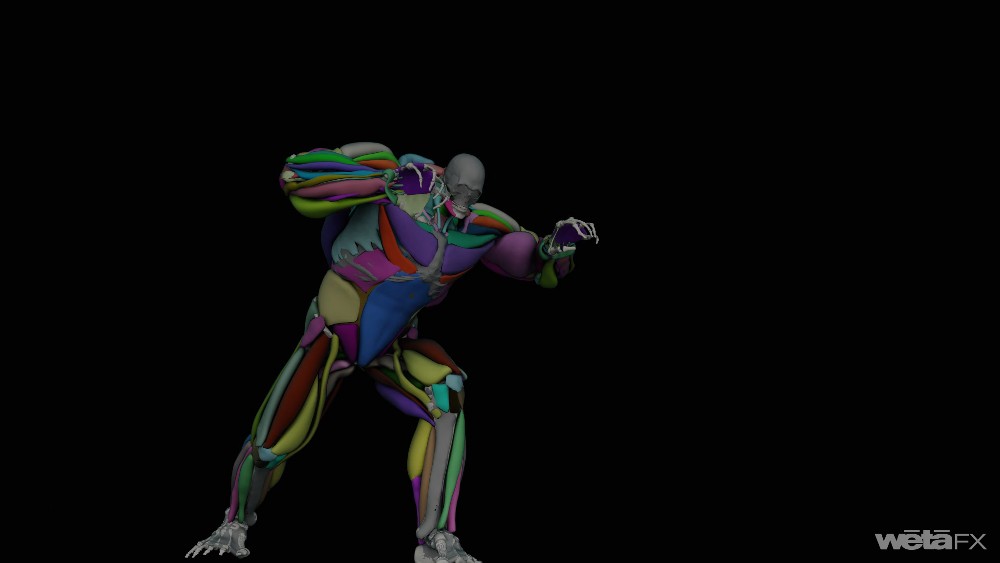
BTL: I’m curious how the MCU ties together in terms of the VFX work. There are characters in She-Hulk that have appeared in other Marvel projects, and Wētā works on those, so were there any assets you could pull from?
Williams: There’s a bit. When I say that I didn’t work on any of the Hulk stuff, Wētā did the Hulk stuff for Infinity War and Endgame, and they would have done some smart Hulk stuff for them. By then, Hulk had become Smart Hulk, which is different than Hulk. We had the asset in-house for Smart Hulk, and it was just a matter of polishing it up and bringing it up to the [specification] that was the modern standard for the company. The other thing we had to do for Smartie was, the work we did in Endgame and Infinity War… was mostly action, and this was a lot more dialogue. We had to extend [our] facial [system] to reach more facial shapes.
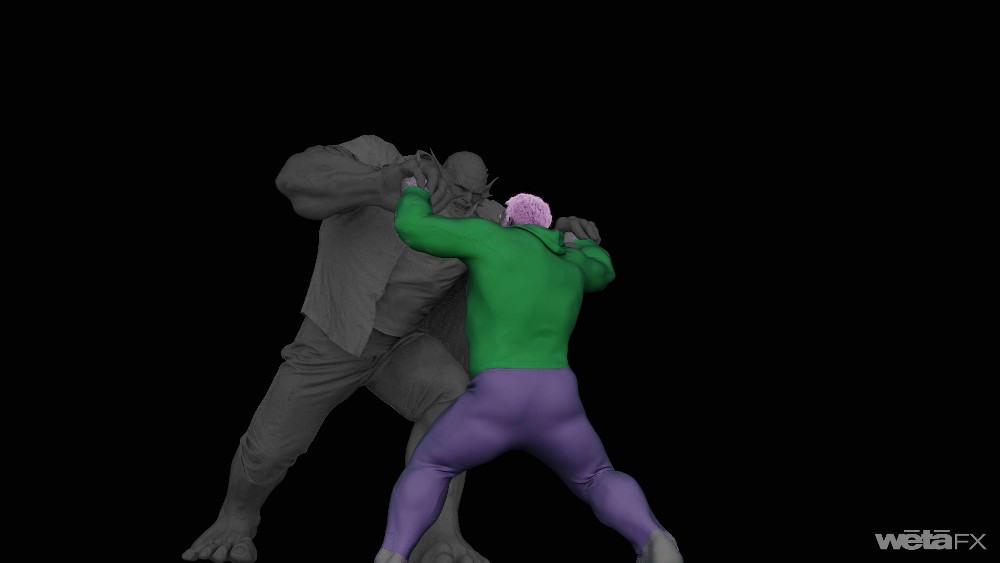
BTL: She-Hulk definitely breaks away from some of the other Marvel stuff that Wētā has been doing. You’re not just using VFX to create powers or environments, you’re creating fully CG characters. Is Tatiana wearing the capture suit the whole time, or only part of the time?
Williams: It’s a good question. The main thing Wētā believes in is performance. If you’re going to spend a lot of time and a lot of effort finding somebody who you think embodies the character that you’re trying to create, and then you work with that person to create that character, the worst thing to do, in our mind, is then throw away their efforts and replace it with some digital thing that is [created] after the fact. We’re strong proponents for supporting the performance created by the actor and the director.
To that end, one of the main things that we encourage is, if you’re going to do mocap, you have to do mocap with your actor, and the best way to do it, if you really want to get a good performance from your actor, is just like if you’re shooting a live-action movie. You don’t shoot your “two people talking” scene without the other actors present; you shoot them talking to each other. If you’re gonna shoot your digital character in a shot, have the person being mo-capped in the shot, too. That’s the performance that you want. It’s all about building a shooting environment — what we call an “in situ” mocap, where you’re gathering everything you need to create the character, but you’re doing it in the least intrusive way possible so that the actors can perform and do their job right.
They have a job to do as well, and they work really hard to do it. You don’t want to be a thorn in their side while they’re trying to do their job, so you’re trying to craft the best environment for everybody to give the best performance. To that end, Tatiana was on set performing all the She-Hulk roles. She did wear a mocap suit for all of it when she was doing that, including a helmet camera.
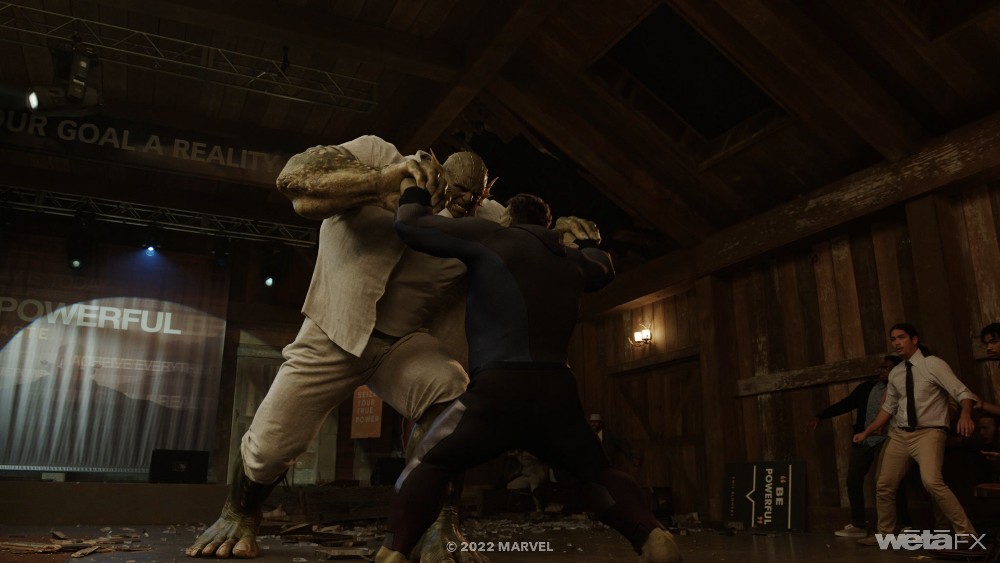
The main challenges we had to deal with [regarding] her were the things that we had to deal with [on] The BFG. The actor is not the same size as the creature, so in BFG, Mark Rylance is 5’6″ or whatever, and the Big Friendly Giant is, like, 14-feet tall. We had to accommodate some kind of setup that allowed us to put Mark at the right height. The same thing with this. Tatiana is five feet [tall] in heels. I’m just kidding. She’s a little bit taller, she’s like 5’2″ but She-Hulk is like 7’6″. She-Hulk is very tall, so we had to put Tatiana on a two-foot riser, so that [she was] like 7’6″ or [close to it]. And she holds very, very tall.
We had to put Tatiana on a two-foot riser because one thing we really don’t want to get into changing is [the] live-action performance of actors. What I mean by that is, when she’s talking to a live-action performer, you don’t want that person looking in the wrong place. Ideally, they’re looking at something other than a tennis ball. They’re looking at Tatiana’s face because two actors can riff off each other a lot better if they see each other. The goal [was] to put Tatiana at the right height so that other people are seeing her, and then, she acts normally.
The only thing you have to be a little bit careful of is that she’s on a riser, so she can’t walk off the end of it by accident. She has to be aware of her position, but a good actor knows where their marks are, so they’re pretty comfortable and safe there. The only thing we had to clean up — and this is just unavoidable — is if Tatiana takes seven steps to walk across the room, She-Hulk might only need to take five. If we scale She-Hulk’s steps down so that she can take seven steps, it looks like she’s doing a little shuffle across the room. There’s a little bit of cleanup you have to do on walking scenes to make sure that Tatiana doesn’t feel like a small person walking across a big room. It’s all because her legs are longer as She-Hulk. That takes a little bit of massaging. There’s no good answer to that, unfortunately. There’s no magic formula for extending a person’s gait.
One of the things we’ve tried in the past is, you try to do something where you capture and have the other actors perform their role, but you’re only doing the mocap, [so] then Tatiana’s movements can be right. It’s a six-one-way, half a dozen another [kind of] situation, where there’s no real right answer. There’s no pure dozen. You’re trying to figure out the best compromise. Because of budget constraints here, and also because the main thing we want is not her gait [but] her facial performance, putting her on the riser was the best option.
BTL: The whole show breaks the fourth wall, but the visual effects budget joke in the ninth episode goes beyond.
Williams: I thought it was very tongue-in-cheek. I don’t know how much of that plays to us, and how much that plays to the general audience, but we’ll see. I appreciate a good self-referential joke.
BTL: You mentioned you had a camera on Tatiana’s face. I know that Wētā has done facial capture on the recent Planet of the Apes movies, but was that not an option on this one?
Williams: When I say we had a camera on her face, that’s what I mean. It was a helmet camera rig. It’s what’s called an HMC — helmet-mounted camera. It’s two stereo cameras on a titanium boom arm that goes in front of the actor’s face, and that’s how we do motion capture. That’s how we’ve done it for Apes, that’s how we’ve done it for Avatar. It’s a pretty standard way of doing it.
BTL: For some reason, I thought the actors would have dots on their faces.
Williams: There are dots on the face, but the two cameras see the dots very clearly. The reason why you put dots on the face is that the cameras are actually infrared cameras. The reason we use infrared cameras is that if a person walks in and out of light, you don’t actually get light corruption to the track. She can walk from a dark room into daylight, and the infrared cameras will see the dots very unperturbed, whereas a visible spectrum camera would have a problem with it.
Having two of those cameras, you then pass it through a piece of software that tracks all the dots, and it creates positional data for the dots, which then goes into a facial solver, which takes the positional data from the dots and figures out the back system for it. I make it sound easy, but Sid will tell you that there’s a lot of black magic and sorcery that goes into those two steps because it’s a very interpretive step.
[At this point, we’re joined by Sidney Kombo-Kintombo.]

BTL: Sidney, this offers an interesting challenge for you as Animation Supervisor since you’re not creating a character or creature from scratch, but one from an actor’s performance. How do you integrate a live-action performance with what you need to do in animation that the actors can’t do, like some of the action beats?
Kombo-Kintombo: We had to acknowledge what was the retargeting of Tatiana’s performance. It’s not a one-for-one. That’s the first thing, like Guy was saying earlier, that looks obvious, but [is] actually tricky for us to figure out. You need character development, because Tatiana is a real person, like us, and we are transferring her personality to somebody that is much bigger, much taller, and way stronger — and a fighter, which is not what Tatiana is. You just have all those steps that come into play, and the first step for us is to see when Tatiana does a movement, how would that movement translate into the whole body? That’s where the consideration of weight comes into play.
Tatiana can throw her arms really high, but She-Hulk will maybe go just 70 percent of that, because of inertia, because of the weight that she’s carrying. On the facial side of things, we want to have Tatiana [there], so we know that’s the one that we want to be as close as possible to. What we do when we are in that process is to try to identify what are the features on Tatiana’s face that we can pull as close as we can to She-Hulk. Everything that is muscle memory, wrinkles, all that stuff, we try to make sure that we don’t miss them so that when you see Tatiana’s expression and you see She-Hulk’s expression, even though their faces look slightly different, you still can read that it’s Tatiana performing what She-Hulk’s [face] is.
BTL: I really liked that She-Hulk is just as much Tatiana as she is a Hulk. Before Endgame, we got used to seeing the Hulk as a completely different-looking beast than Ruffalo. The first episode is pretty much Hulk and She-Hulk on Hulk Island communicating and fighting. I’m not sure how much of that is Mark and Tatiana in those fight sequences or how many stunt people were involved, but there are many objects being thrown in that fight. How much of that are you getting to work with from set before you have to do what you do?
Kombo-Kintombo: What is fun with that process is that we are in such a good place in our relationship with Marvel that they [include us] in the process of creating some of the moments in their shows. Episode 1 was definitely a big part of that. So basically, even before they go on set to shoot, we create some previs for them to base their shooting from. This relationship starts even before what happens on set. The way it plays is that they come with a pitch. They tell us, ‘Hey, we would like these two to fight like the big brother with the annoying little sister that comes and tries to be annoying, and then start hitting harder and harder.’ That fight develops that way, so they came [in] with that pitch.
What we did with the previs team [was], we started to brainstorm what a kid fight would be. The director, Kat [Coiro], came in with some ideas about putting the hand on the head to push back. Basically, we tried to establish a ramp-up in the fight, going from what the actors could do on set to what would be fully CG and where we like to live as animators, where we have the full freedom to crack walls and all that jazz. That’s roughly how it started. We previs’d, they go on set, they shoot whatever the actors can do.
They know where to place the cameras because now we have been there [for] some time. [That] wasn’t really the case on this one, because of COVID, but sometimes Guy can even be there with them to make sure that what we have set up is exactly what they are setting up on set. After that, we go in, and we take the performance that they created, based on what we previs’d, and we readjust the shot to create them. That was somewhat the workflow mainly on Episode 1, and we did that for the fight scene [and] for the lab, [and] for the training montage as well.
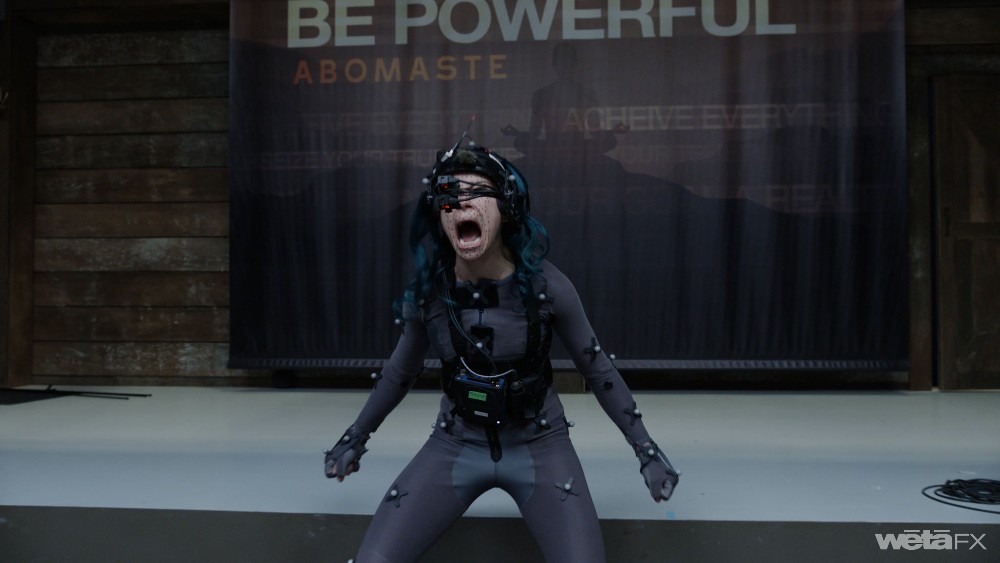
BTL: Right, the training montage that turns into a fight scene. I know Wētā has stages there, but do you actually work with stunt people there to create previs?
Kombo-Kintombo: Yeah, we do that. For She-Hulk, it was interesting, because we needed to understand how with a CG character, what do we have mainly? We have [many] male full CG characters — you have Rocket, you have Thanos. When you put aside Alita or Neytiri [from Avatar], it’s not often that we have female characters leading the show. When we go on stage, we try first to make sure that we understand Tatiana as much as we possibly can. You watch shows, you try to pick [up] on some [tics] that she has. You try to analyze how much her hips bounce left and right when she walks. Because all of that is part of what is making her [her], so that when we have to create motion, both physically or facially, what we make sure of is that the audience will see that as being potentially a Tatiana performance. It’s not that we create the CG character that we try to make beautiful. Our main target is [the] likeness, to make sure that somebody resembles Tatiana. We want to make sure that when you see She-Hulk, you see Tatiana. Because Tatiana is handsome, She-Hulk becomes a handsome character. That’s basically how we approach those moments.
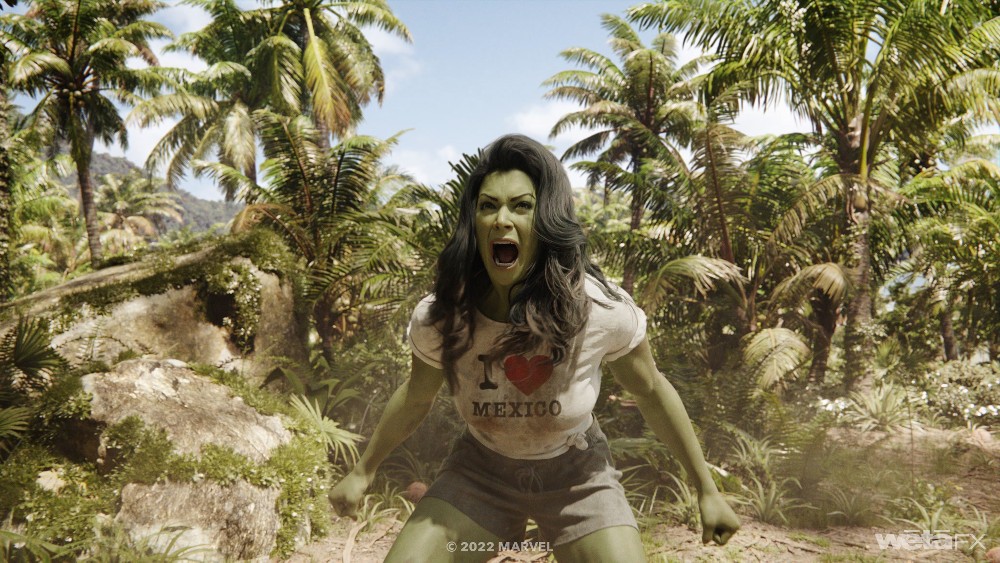
BTL: When Hulk and She-Hulk are throwing things at each other, are all of those objects created by Wētā?
Kombo-Kintombo: That’s the fun part for us. You ask any animator, they’re gonna tell you, “Creating previs is cool,” because the director comes up with those ideas that they basically throw at you. “Oh, I would like this and I would like that,” and you try to find a way for all these elements that she gave to you to make sense in the flow of an action [scene]. We knew that they were on the beach, and you start just thinking, “what can it be that they are throwing at each other there? Is the Hulk a surfer? It could be cool to have him as a surfer there, so let’s have them throwing…” [It’s important to always visually have objects that the character can interact with and [help] integrate them into the environment that they are in. It’s not like they’re trying not to touch anything. When you make them touch things, they belong even stronger to the environment that you create. We always try to make sure that you see them touching something [and inter]acting with something that is around them.
BTL: Guy mentioned how Tatiana might walk across the room versus She-Hulk, so what was involved with that on your end of things? Do you reanimate her performance in that case?
Kombo-Kintombo: The important part is point A and point B — do not mess up the story. There are some very important beats, and analyzing what the important beats are in the overall performance of the actress, of Tatiana, you analyze what those beats are, and make sure She-Hulk hits those beats. Once she ends up where she needs to end up, sometimes it’s a little bit of a sacrifice. If we can’t keep everything, what is the thing that we absolutely want to keep? Usually, the eyeline — making sure that Tatiana’s eyeline is still exactly where the director framed Tatiana’s eyes, so we made sure She-Hulk’s eyes are exactly in the same spot. It may be [different with] the body slightly because she’s bigger, but at least the eyes, the intention of the shot from the director and the performer is fully respected, because we have the eyes where they were supposed to be, and she’s looking where she’s supposed to look. To summarize that, it’s just to say that point A and point B are important, but the main thing that we focus on is making sure that the story points are being hit properly.
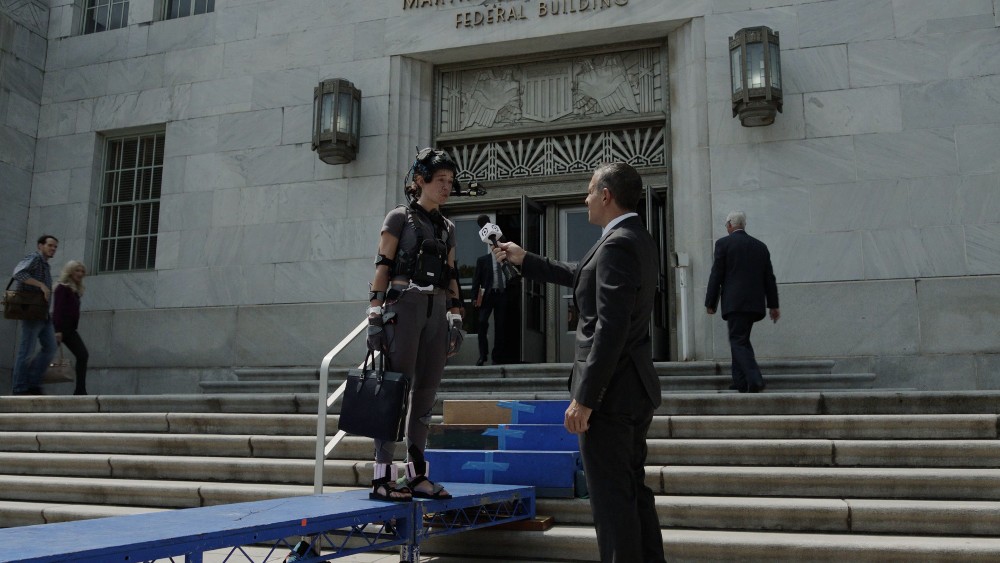
BTL: Guy also mentioned that Tatiana was walking on a riser. I’ve seen some productions where they have actors playing what will become taller creatures and they’re using blades to walk and maintain that height.
Williams: It’s totally doable. Back to Sid’s point about performance and emotion [though], it takes a lot of effort to do that, and it distracts. We don’t want to be a thorn in the side of performance. We don’t want to ever request something that makes the actor aware of something other than their performance. Everything we do is to try to… make the suit as non-intrusive and as comfortable as possible. We make the helmet as light as possible. Used to be we had a light on the helmet [but] now it’s an infrared light so that there’s not something shining in the actor’s face. We do everything we can to try to pull our system away from the actor, so the actor can act.
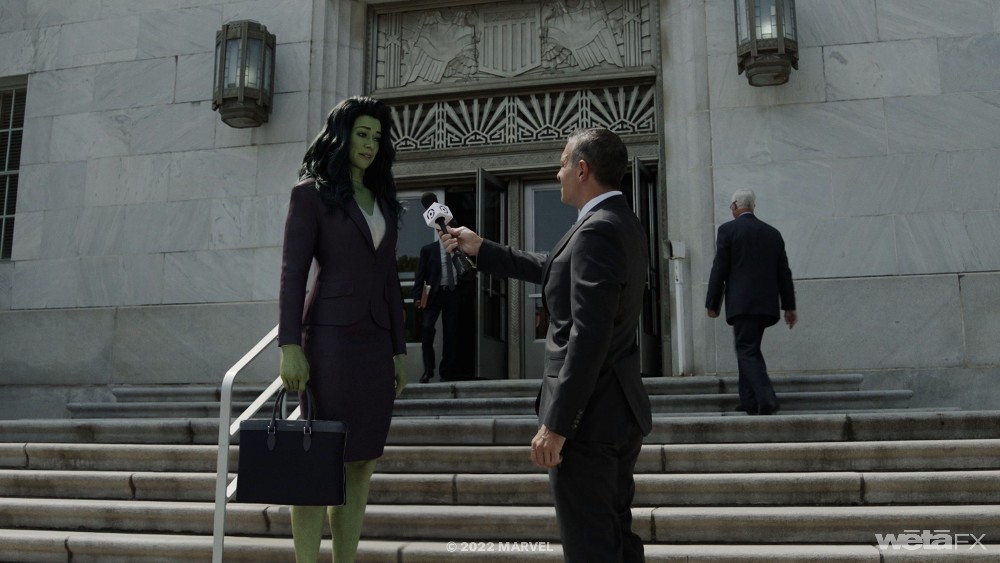
BTL: Sidney, I know you worked on some of the Avengers movies, and Guy mentioned you may have had the Smart Hulk asset from Endgame. I was also curious about whether Abomination, who appeared in Shang-Chi, was also still in-house?
Kombo-Kintombo: I wouldn’t know about Abomination. I don’t know if we had him in-house before, or if he was a total ingest. I know that Wētā being Wētā, we tend to try to go the extra mile, so I know that on the facial system, we built that fully. I know that we refined a lot of body parts to make sure that the way this character was moving would be convincing. The one that we fully created, because this one didn’t exist, is Skaar — that one was the first time that we saw [him] — and also, Todd Hulk, [who] was just a pleasure to play with.
BTL: One thing I read in the Wētā breakdowns for She-Hulk is that you had to create “destruction-ready locations,” so every set on which there was fighting, you had to create the destruction on your end. What was involved with that? Were you LIDARing entire sets?
Williams: When it comes to set destructions, we LIDAR what they built. We did a little bit of destruction to the garage. It didn’t get damaged, but things are affected so we LIDAR’d the garage that they built. The bar gets totally destroyed, so we had to LIDAR that. It’s more that we have to make sure the ground is destruction-ready. We have to make sure any boulders that he interacts with are destruction-ready, [and] all the trees are destruction-ready.
Anything that gets destroyed has to be modeled in such a way that when it goes to the effects department, it wants to break. If she throws a surfboard, the surfboard has to be a closed volume, so the software knows how to break it apart. If you want to break a tree, we have to make sure that we model splinters, so that the tree comes apart and actually splinters properly. It’s all that kind of stuff. We take what they give us [and] scan what they do, but for the most part, their builds were one tree or two trees beyond the set.
BTL: I’m always curious about how much they are trying to do in-camera. There are things like her green eyes that can be done with contact lenses, but is there still stuff you guys had to enhance when she hulks out?
Williams: Because of the transformation, for the most part, we just did that. She didn’t wear green contacts, because when you’re shooting a setup, you’re trying to leave yourself a little bit of latitude of when the transformation happens. You don’t want to put green contacts in, and then have to paint them back out. Changing the eyes to be green is not that hard to do, so that kind of stuff we did in post. There’s definitely stuff that they do in-camera. The show is not really the kind of show you’re going to get away with much, because 90 percent of your work is a giant green person, whether it’s She-Hulk or Smart Hulk, or Todd Hulk. There’s not much you can do in-camera.
Kombo-Kintombo: To the point you made quite some time ago, Guy, it’s also the fact that if they try to do stuff onset, it sometimes becomes harder for us to clean it up, rather than going directly into the CG world with those elements.
Williams: A great way to think of that is if something you do on set is 85 percent successful, there’s often this feeling that if you add 50 percent more effort in visual effects, it’ll be perfect. To Sid’s point, no — you spend 20 percent effort just to get it out of the shot, and you add 100 percent more effort to replace it, and then it’ll be perfect. Often, if something’s in set, you can’t just fix it, you have to replace it.
There is one thing in the series that was done very practically, and I thought it was absolutely brilliant. I think it was the start of Episode 9, where they homage back to the original Hulk title sequence. That was done with a guy wearing a green suit to look like a woman with a wig. They leaned into it full-on to make it look [like] 1970s visual effects. It was absolutely fantastic. I might be mistaken. It might have been a female in the suit, I couldn’t tell, but it looked like they took some Lou Ferrigno-type person and put them in a suit just to be obnoxious. I wasn’t there. I’m not exactly sure how they achieved it [but] I know it wasn’t visual effects.
All episodes of She-Hulk: Attorney at Law are now streaming on Disney+.





